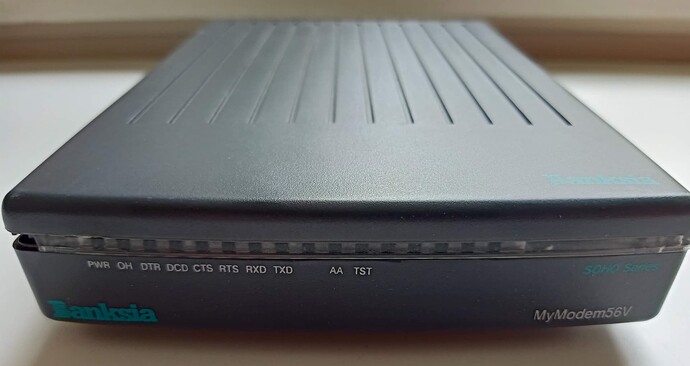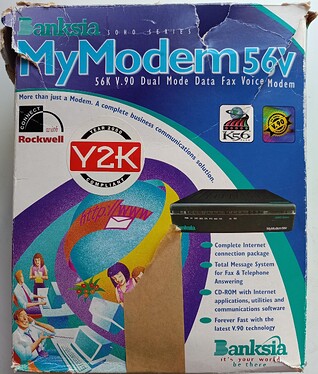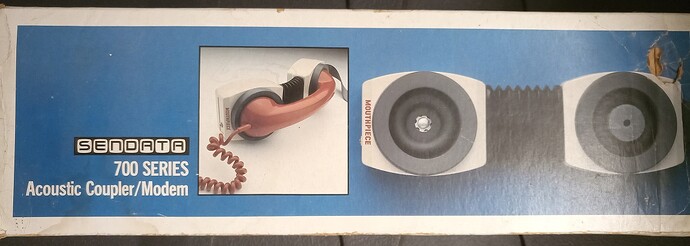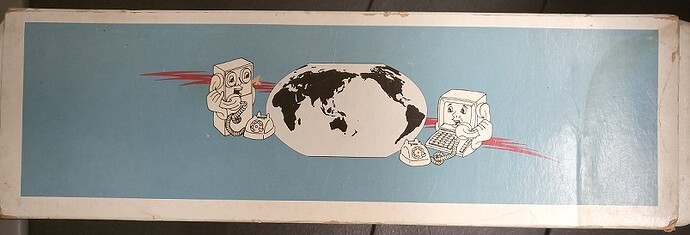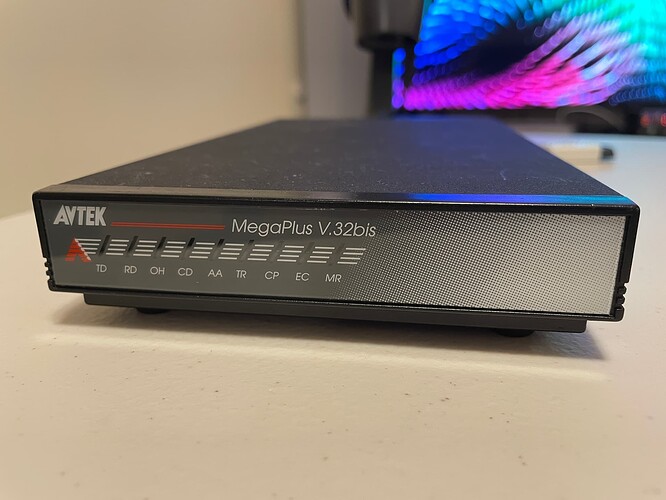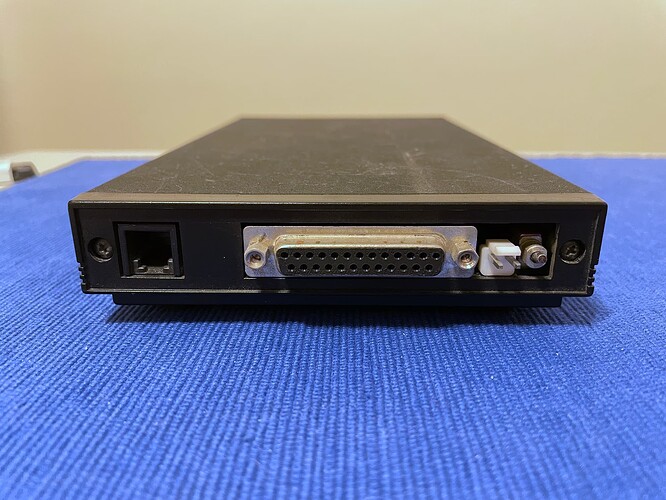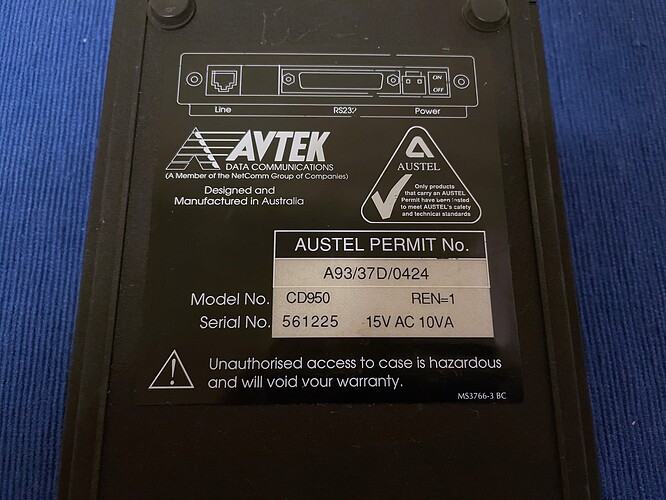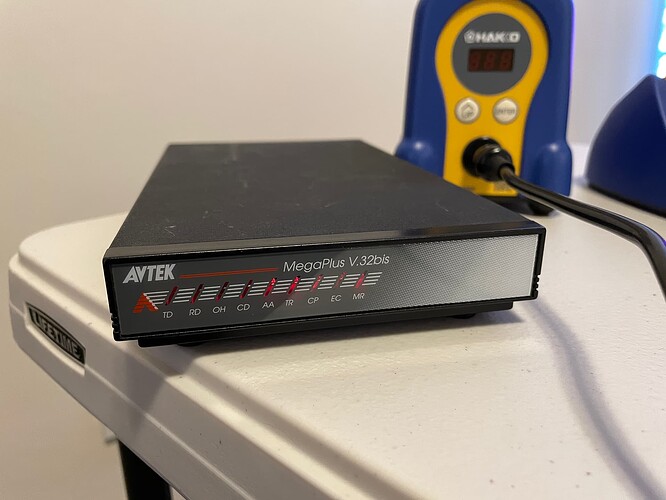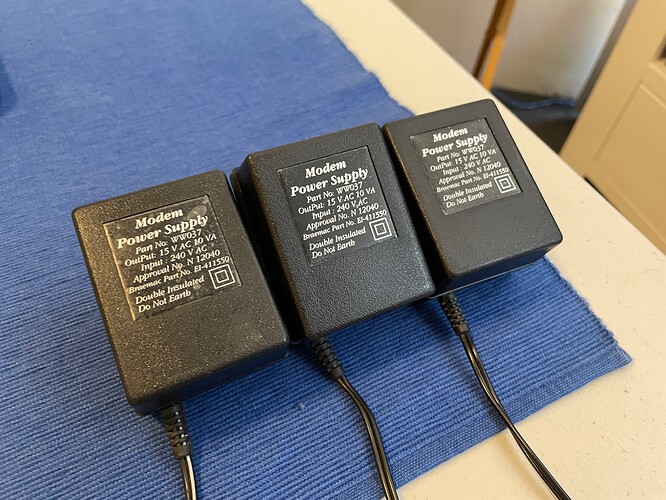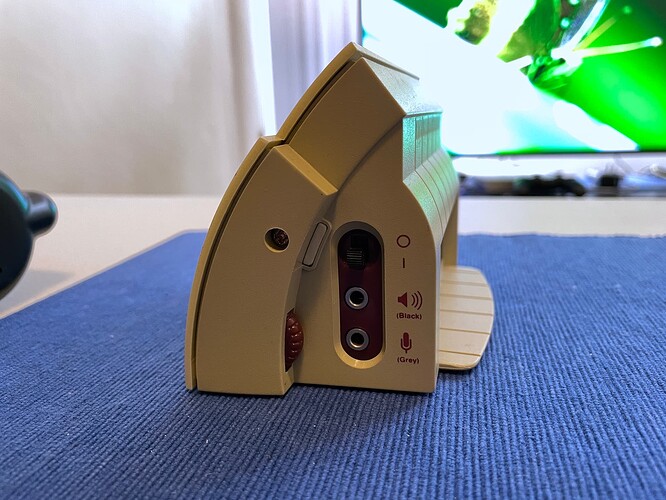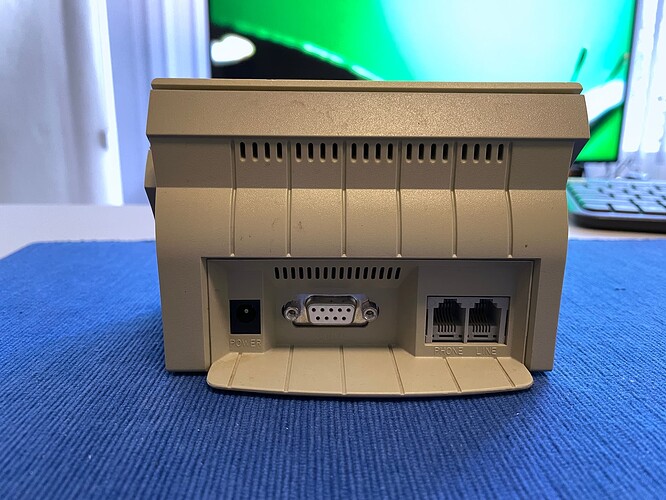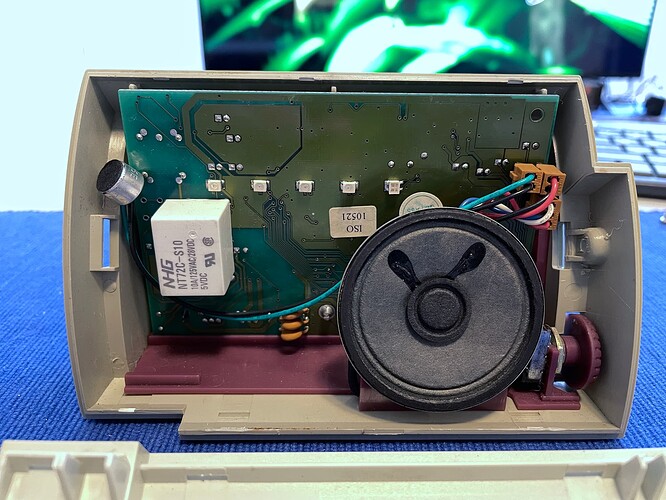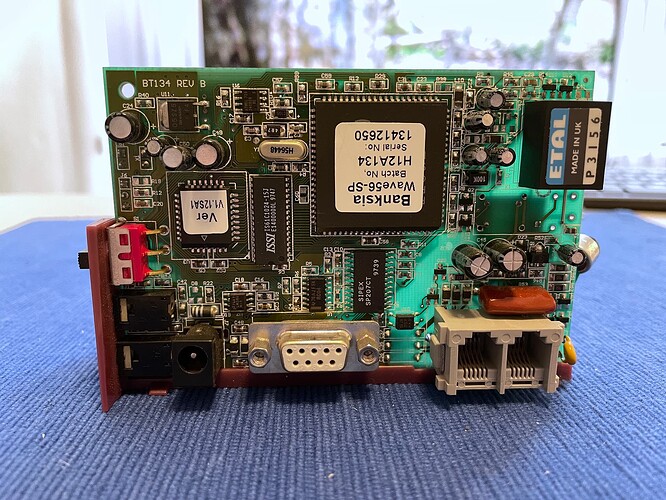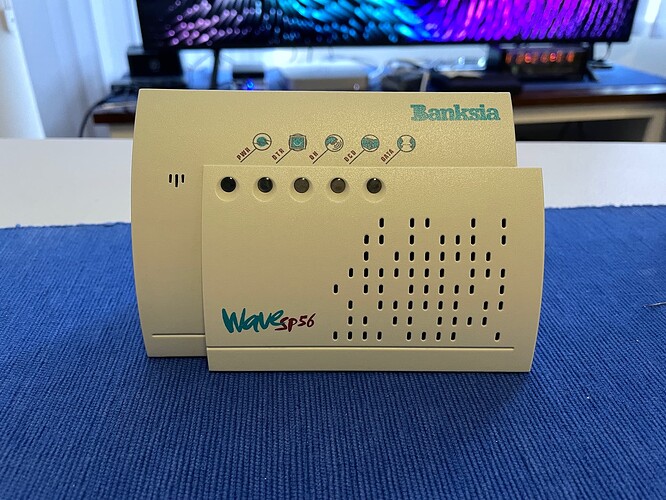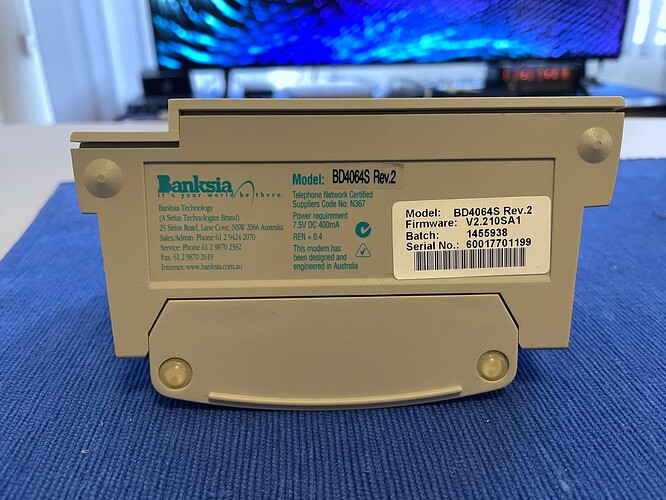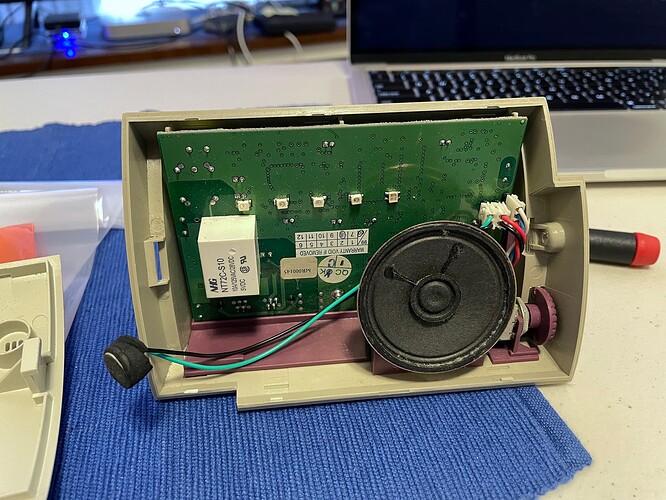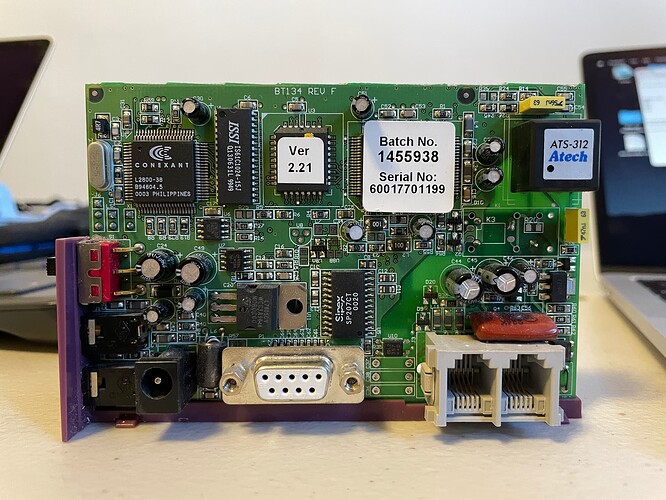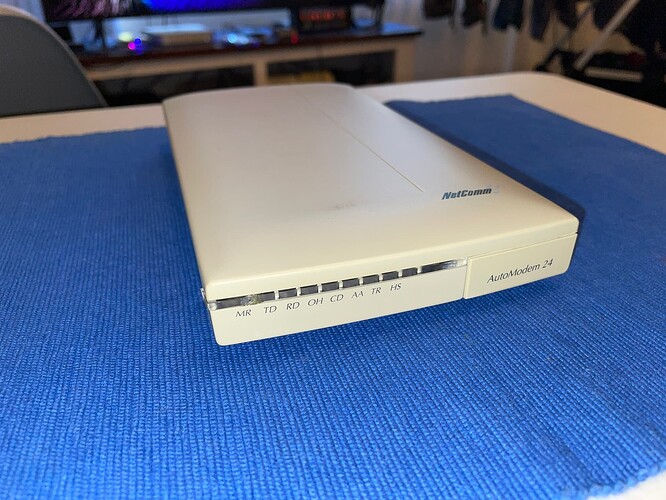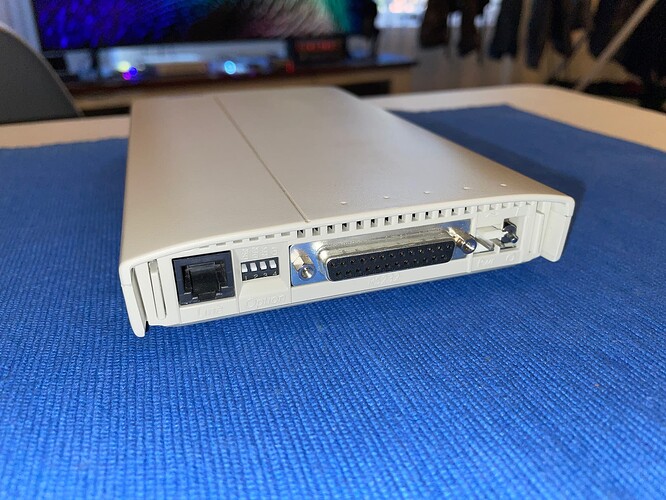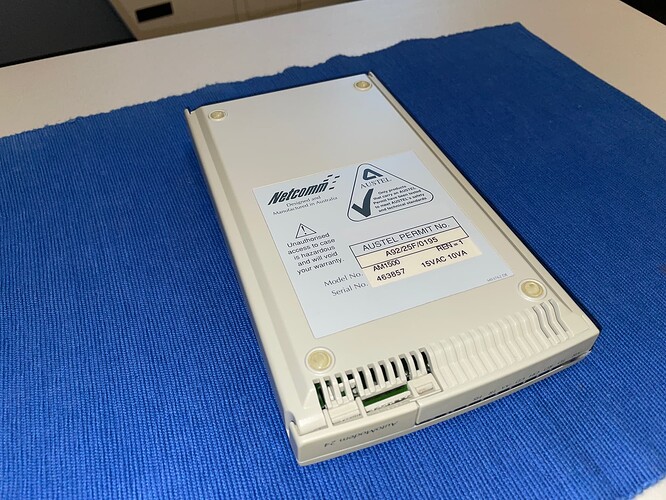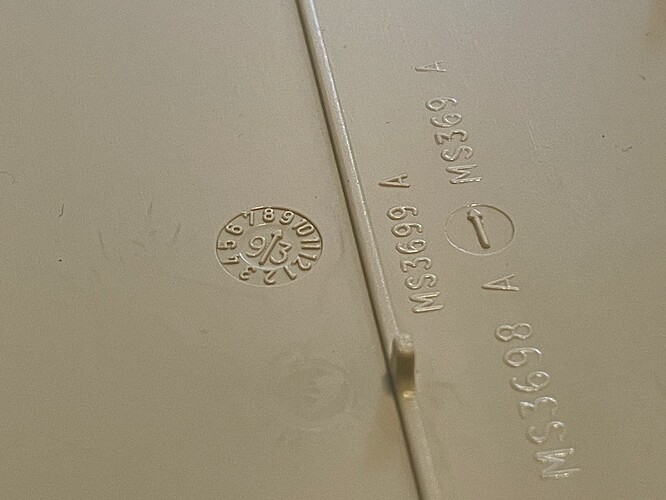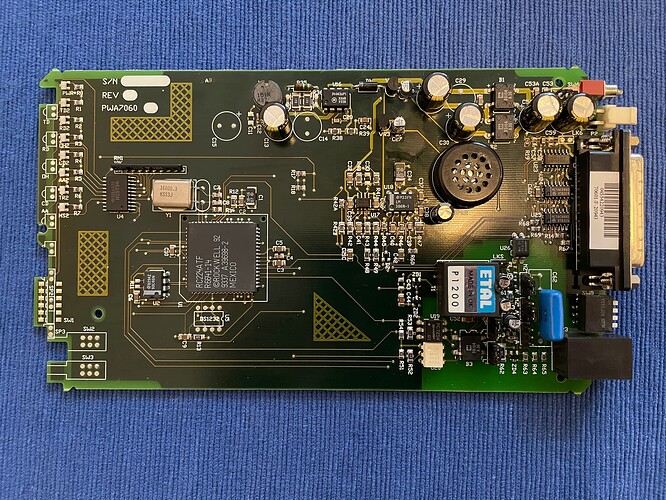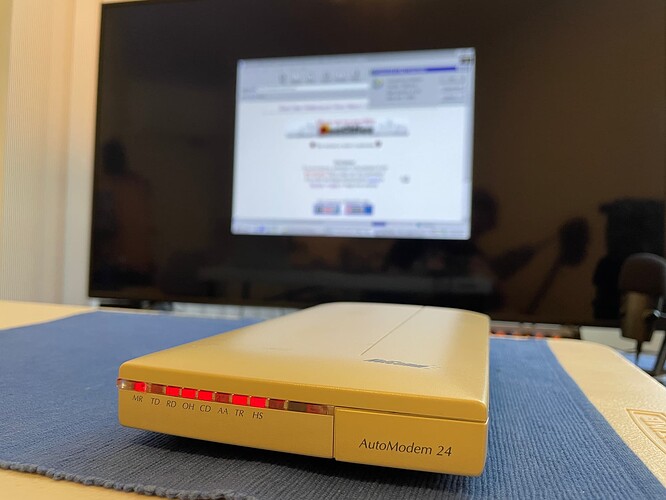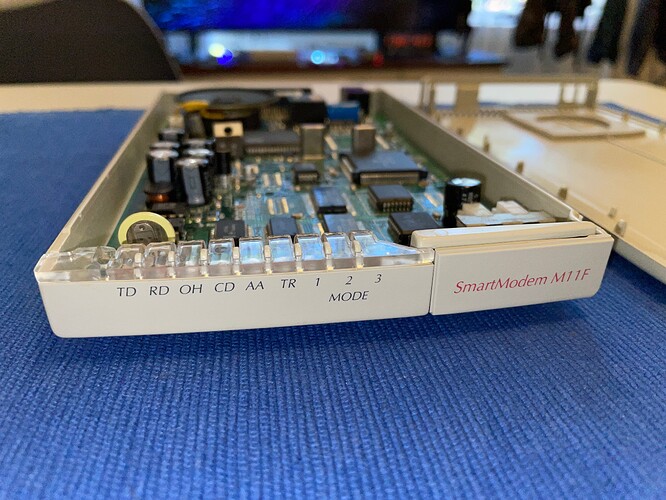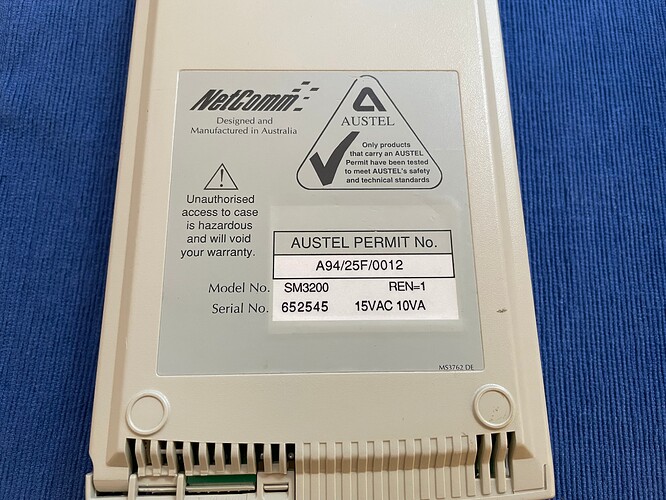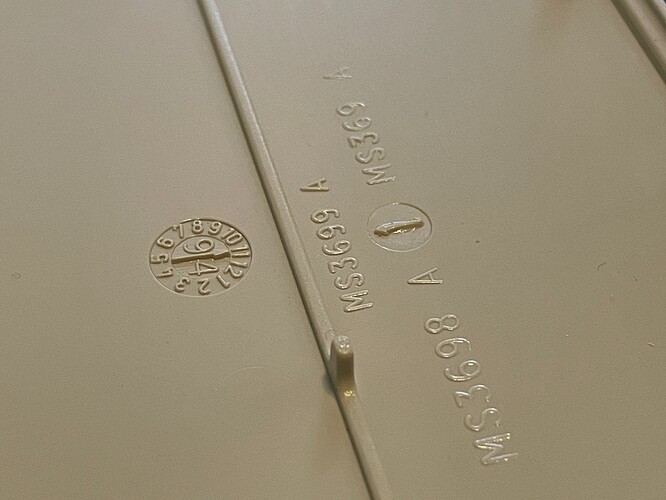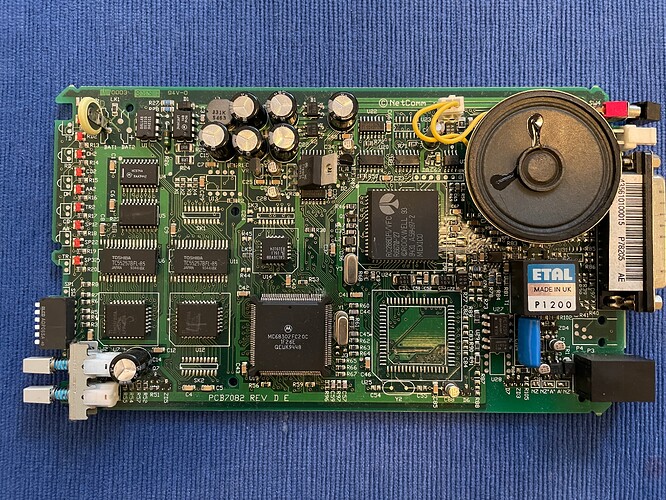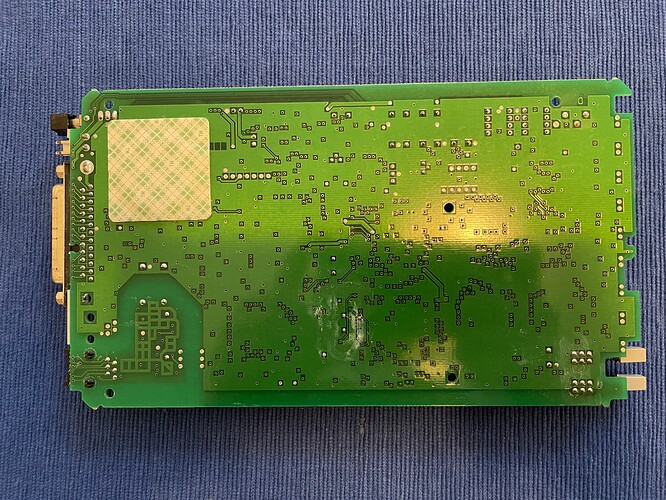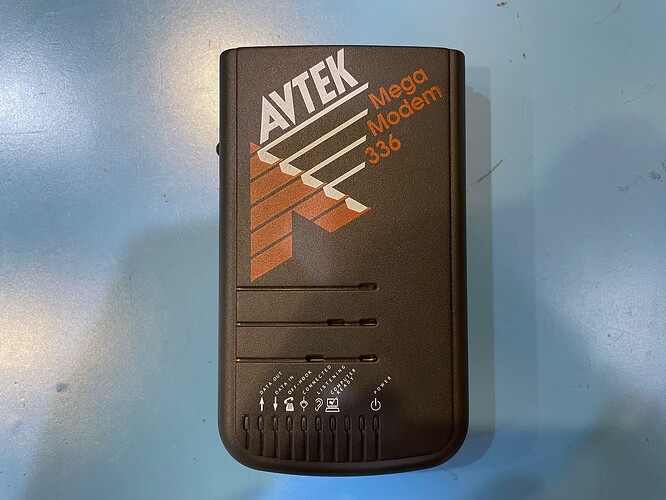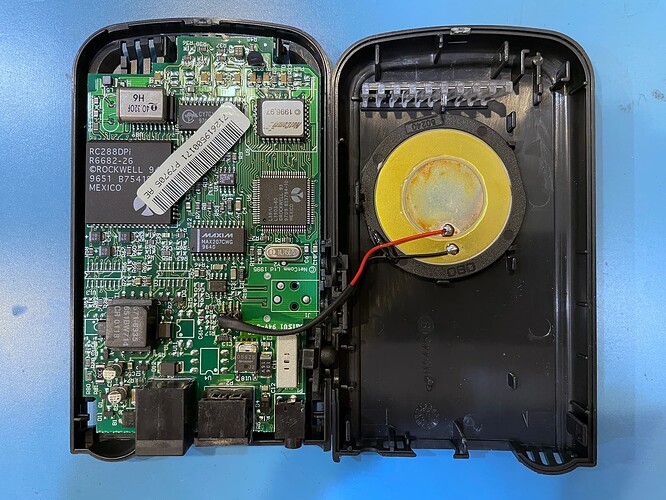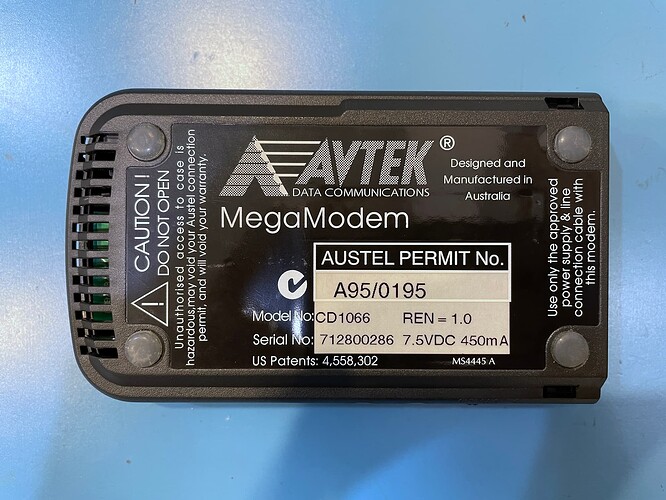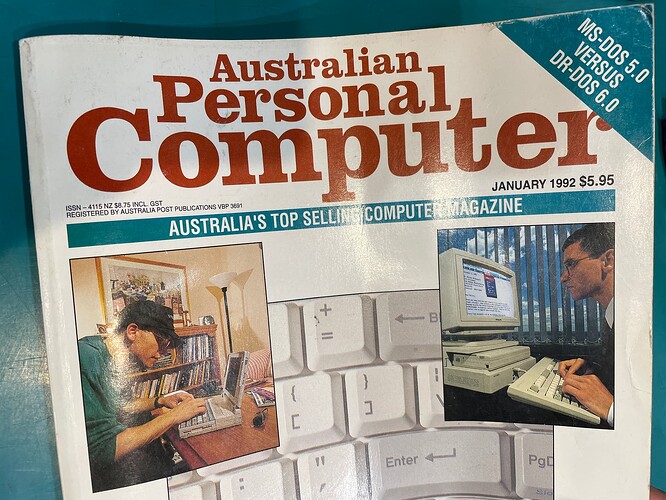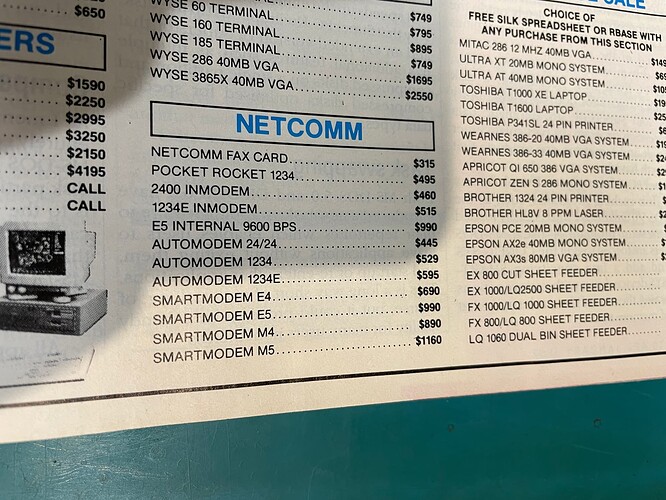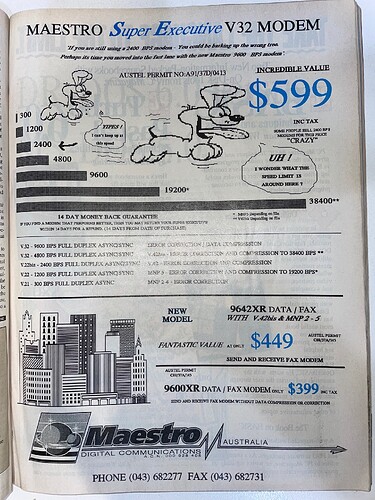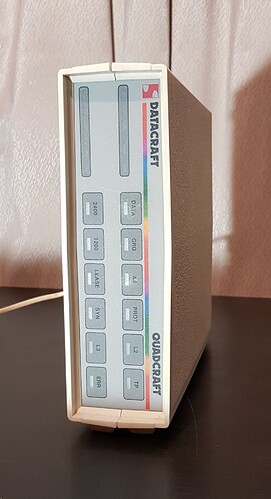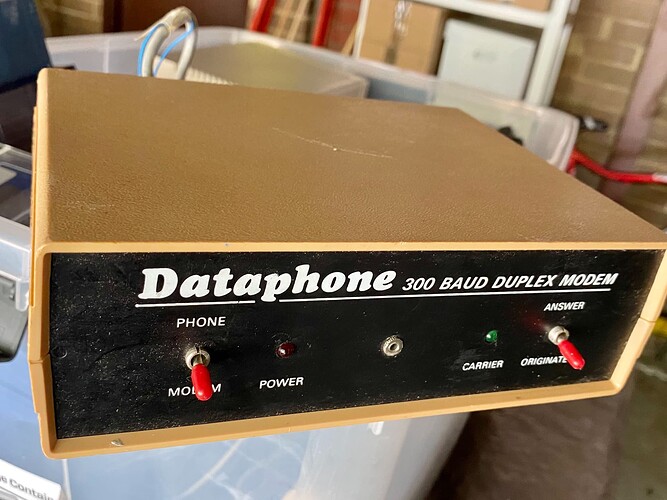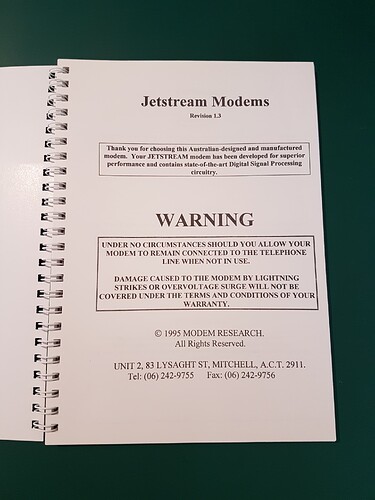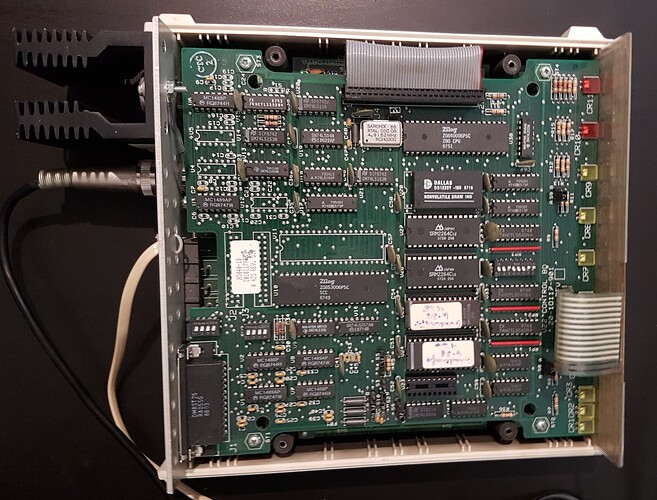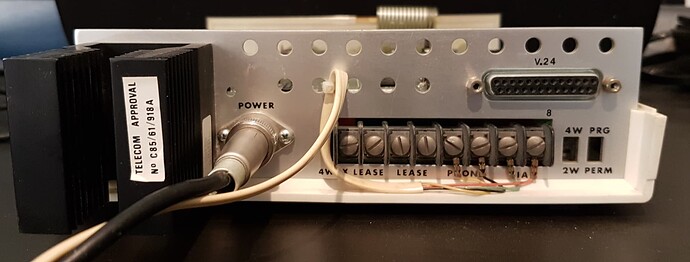Not at all. That modem served my brother and I so well. I remember still buying it in Dumeresque Street Campbelltown with him after school in probably 96 for some massive price for two teens. But it made dialling into a local BBS much better and Ozemail just woooooooosh lol
The SmartModem was such a popular line. Tesseract RCPM BBS came with one, I think it was the 1234SA. Hopefully someone has one and posts a photo.
Here’s my Netcomm collection: an old and an end run. As a “winmodem”, the Rave III is arguably less modem than its ancestor.
- Netcomm Smartmodem 1234, ISA bus, 2400 baud
- AM5066 Rave III, USB 2.0, 56kbps
The Banksia MyModem was a popular line of Australian modems. My first one was the 14.4kbps model in the early 90’s. The case colour and design stayed the same as they upgraded the modem capabilities. I rescued this 56kbps model in 2020.
Banksia MyModem56V, external RS232, 56kbps
Luckily it’s Y2K compliant:
I’d forgotten the banksia in this form. A few staff rooms in my high school had them. Quite a stable modem!
Hi
I have a SENDATA 700 series acoustic coupler / modem.
This one made it’s way to South Africa back in the 80’s (not sure when these came out)
It was given to me around 1988. It and a small Panasonic B&W composite video monitor are all I have left of a huge Apple 2 collection. Gave it all away when I moved out of my parents house. I’m sorry I gave it all away. They provided many years of joy.
The modem and I now live in Brisbane Australia.
Regards
Andre
Interesting that mine is made by sendata and yours by Electro-med. They must have made a few. Mine isa 700B SN 6105
Can anyone share photos of Maestro Supermodem For Apple II Computers Model AEM 4610 (the original ebay listing has expired)
Australian modems, my favourite type of modem! Here’s a few I have lying around. The NetComms and the Avtek share the same 15V AC power supply. The later Banksias were 7.5V DC. Enjoy!
Avtek MegaPlus V.32bis Modem (CD950)
14.4 kbit/s
Banksia Wave56-SP V1.12SA1
56 kbit/s
Banksia Wave56-SP BD4064S Rev.2 V2.210SA1
56 kbit/s
NetComm AutoModem 2400 (AM1500)
2.4 kbit/s
NetComm SmartModem M11F (SM3200)
Bought as a 14.4 kbit/s, but might be a 28.8 kbit/s model.
Thanks for all the photos! Showing the circuit board is going above and beyond ![]()
Good catch on the Avtek. One just popped up on ebay with this description:
Blockquote
A Rare Avtek 336 External 1980’s/90’s Era Compact External Vintage Computer Modem- Rare Aussie Made-Fast Post!. This listing is for one rare vintage Australian made external Avtek 336 Mega Modem. Sourced from a recently closed retail electronics business, this 1980’s/90’s era external computer modem was stored in a glass display cabinet at our shop, it is in excellent physical condition with very few (if any!) marks or scuffs. The specifications are as follows. Speed- 28,800 Bps. Required power input- 7.5VDC 450mA. Connector Lead- (Included) DB-9 Female. Dimensions- Length 12.5cm x Width 7.0cm x Height 2.0cm. Manufacturer- Avtek Data Industries Australia. With vintage computers and accessories rising in popularity and bringing big prices there has never been a better time to put together a nice vintage computer system for yourself or resale!. This Australian made external Modem is now quite a rare item and really compact and well built for the time. It would be ideal for any vintage computer system.
No worries, I’ve been giving some of them a long overdue recap. When that Avtek 336 arrives, I’ll pull it apart and take a few snaps as well.  I had one in the same form factor as above but twice the speed at 28.8k (V.34). Good memories.
I had one in the same form factor as above but twice the speed at 28.8k (V.34). Good memories.
I was digging around the press releases in Wayback a few weeks ago to do with NetComm, Avtek, Banksia, Simple and Sirius and came across a few interesting tidbits on their convergent histories.
- NetComm Press Releases (via NetComm)
- Avtek Background (via Avtek)
- NetComm Background (via Avtek)
- Avtek Price List (Jan 1998)
There’s plenty more to be found of course! Wayback is a gold mine if you can find the right links to click into. Very interesting thread to watch! 
Avtek Mega Modem 336 CD1066
I want to say 33.6 kbit/s. Will confirm if it is otherwise…
Also some interesting tidbits from a couple of magazines I came across. First up, APC January 1992:
Don’t worry, I’ve got a Maestro E336V on the way. Next up, an advert from Simplemodems (later NetComm) in Australian MacWorld Dec 1993 / Jan 1994:
I like their little fair-use clause on the side. Here’s a photo of Ray, but he has nothing to do with NetComm. Except he was a co-founder. And made modems. No similarity at all! ![]()
Have you found leaky or shorted caps and are there any brands / models of modems where the capacitors especially need attention?
Is Saruman a candidate?
The Saruman was a locally made design (not just Australian, but from Melbourne). It also used to overheat as there’s absolutely no venting or much room in the case. Came out in 1994.
What a great find. Thanks @EdS. Not only an Australian modem, but also a world-record contender for the highest number of status LEDs
I wonder if their marketing played on the Lord of the Rings theme:
Saruman: one ring to sync them all
Saruman: your precious modem
ok, I wouldn’t get a job in marketing… anyone got any others? 
I’m the same person that posted on Mastodon. Thanks @poddmo for the link to the forum.
FWIW:
- Sysop of Cafe Chrome BBS (that ran from 1988-1996)
- Used to work for Brathstray (which was the company that took over all the holdings of Sendata when it went broke, run out of the same building in Oakleigh) doing QA on new modems and repairing old ones (from the exceedingly rare 2400 bps acoustic coupler that Sendata made, their insane 2400 bps modem that was ASCII menu driven and effectively had a terminal program built into it, plus a number of the dial up/fixed line modems used for ATMs/banks), so I’m familiar with their entire range of modems (though I don’t have any sorry).
- Ran test modems purchased for a sysop discount on the BBS for Interlink (firmware upgrades from 9600 V.32, eventually up to 16.8k) and Saruman (basically just giving it a robust workout).
Regarding the Saruman: I don’t have that many details anymore, but the company was based in Northcote or something from memory. I don’t think they made many of them. They didn’t have much in the way of venting in the case, so they used to overheat when the ambient temp went over 30 deg C. I used to run it with the top of the case off and with a fan pointing at it (it was sold to me as a special deal, to be used for the BBS, and I gave them feedback on the design, etc).
I don’t have the InterLink modem anymore. They were in St Kilda, (Upstairs of 117-119 Fitzroy St), and I regularly took the modem in there for firmware upgrades.
Another Australian modem I have is the Datacraft Quadcrafts (2400 bps, MNP3/4/5) that have more LEDs on them than the Saruman (a total of 12 behind membrane buttons, and even more as status lights)! I had 4 of these hooked up to the BBS (started with 4 lines, ended up with 8 just before closing it down), and they lasted the entire time without a complaint. Still got 3 of these sitting around.
Datacraft was based in Mooroolbark. Eventually sold to Dimension Data.
Note: I put the feet on the Datacrafts that way so I could get more space on the desk I had everything on).
Will follow up with internal pics of both. I also have a Netcomm Trailblazer (the rebadged American Telebit Trailblazer), if that is of interest?
PS: I’ll reach out to a few old contacts from then and see if anyone else has info of note on some other Australian manufacturers.
Thanks for uploading the pictures and sharing your history. Two new manufacturers (Saruman and Datacraft) is a real win for the list. I think anything from Netcomm would be interesting - at some point each of these manufacturers would be worth further research and the more we can get added to this discussion the easier that will be.
I nearly fell off my chair - that looks like the first modem I ever used way back on our Datamax 8000 CPM system. Except I don’t remember the socket in the middle. Is there Dick Smith branding on the back or bottom?
Going thru stuff (ie: pulling out the boxes that contain the Quadcrafts and the Trailblazers) and found this manual for a Jetstream modem from 1995! The manual itself is 97 pages. The manual says there are a bunch of modems in the Jetstream series, with max speeds of 9600 (V.32), 14.4k (V.32bis) and 28.8k (V.FC - so pre V.34). Looks like they had External and Internal (ISA slot) models.
Based on the manual, it was manufactured by Modem Research (from the copyright), who were in Mitchell, ACT.
Datacraft Quadcraft - Industrial class modem from the late 1980’s. They supported a Hayes AT command set and an X-series command set (though I can’t remember which). If I ever find the manual in my things, I’ll update the details. They also supported MNP2-4 Error correction, as well as fixed-rate serial speeds. I used to run them at 4800 bps on the serial and turned the buffer size down to 64 bytes, which improved latency for users on the BBS I ran.
They had a massive 23 LEDs on the front panel! At one point, I had 4 of these things, plus 4 other modems (2x USR Dual Standard V34bis & 2x Netcomm Trailblazers), plus a 486 PC, all in my bedroom about 10 feet from my bed. I have no idea how I managed to sleep through all that!
And yes, it still works! Configured in the default mode that I had them in still (Auto Answer). I haven’t hooked it up to a serial terminal yet, but I really expect it’ll just work fine. I’ve got 3 of these (used to have 4).
Edited to add: I should note that all the larger function LEDs on the right side (12 of them) are actually fronted by membrane buttons. You could push these to toggle/switch to that setting.
Sorry about the slightly fuzzy pic, but as you can see, no large electrolytic caps that could fail over time, plus being this old, my guess is they’re still going to be rock solid (none of this garbage import electrolyte).
You can tell these were an Industrial modem. Screw terminals for all the line connections on the back and options for 2 or 4 wire leased line modes. The right PRG/PERM switch is unpopulated, but was obviously a thing. There’s 2x 8pin dip switches on the lower board (just out of shot), and I remember one of them did allow you to lock out saving of programming, so I suspect it was just in parallel with that dip switch. There’s a bunch of jumpers and dip switches on the top board, but I remember that these weren’t in the manual, so I suspect these were for various add-on options or product differences. Power supply was 18VAC Centre tapped, provided on the big barrel connector in the back. In the centre of the heatsink was an LM309K voltage regulator.
Edited to add: One further note. There were a few models similar to this. There was a less-functional 2400bps model that didn’t do Error correction or the like (can’t remember what it was called, but it was the same case with a few less function LEDs on the front), and there was also the Quincraft, which was basically the same as the Quadraft, but it did V.32 9600bps as well. I never had either of those, but knew they existed.

